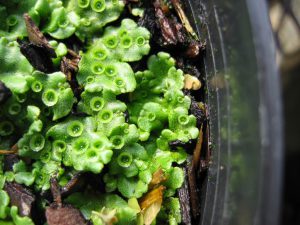Last Updated on October 9, 2017 by Caroline Warwick

Cooler weather and damp, dreary days may signal the start of fall to many Floridians, but to greenhouse growers and weed scientists it means one thing: Liverwort.
“The toughest weed to control in enclosed structures is, by far, Liverwort,” said Chris Marble, assistant professor of ornamental, landscape and invasive weed management. “It is the worst weed for most growers using greenhouses or in shade.”
Liverwort, or Marchantia polymopha, is a common problem in production nurseries and greenhouses. Thriving in cool, moist, nutrient-dense areas, Liverwort can grow in contain-grown ornamental plants, in greenhouses, in propagation and nursery ground cloth areas and in any other poorly drained or moist areas.
Liverwort grows in dense, low-growing mats that quickly cover the container or media surface, blocking irrigation and fertilizer from reaching the plant.
“One of the largest problems with fighting Liverwort is that there are no good herbicides that will selectively control it without injuring the crop,” Marble said. “Here at MREC we are researching a variety of methods – from fertilizer placement to post-emergence treatment – aimed at targeting Liverwort.”
Liverwort is one of the most common weeds challenging growers in the state of Florida, and with fall temperatures and humidity moving in, the challenge will only grow.
For more information on Liverwort, check out Biology and Management of Liverwort in Ornamental Crop Production by Dr. Chris Marble.

 0
0
